
Stage 2 of Meaningful Use is likely to include numerous patient engagement features.
BIDMC has been offering Personal Health Records since 1999 and we’ve learned that patient information must be organized appropriately and wrapped in patient education materials so that the data is transformed into knowledge, and is actionable.
I recently visited my PCP for an annual physical. Ok, to be honest it was my first visit in 4 years since as a physician I am uniquely poor at seeking regular preventative/wellness care. My PCP ordered a Urinalysis, a metabolic panel, lipids, and a CBC from Quest. Quest has a very cool feature that enables patients to upload their lab results into Microsoft Healthvault and Google Health.

Google does a technically elegant but less than useful thing – a list of test names and values in alphabetical order that mixes my urine, chemistry, microbiology, and hematology tests together randomly. You cannot even tell what is a blood result and what is a urine result. There are no educational materials.
Microsoft organizes the results by panel, which is great. Although at times, healthcare data should be organized into attribute-value pairs for mining and analysis, presentation to patients requires persistence of the original format of the lab panels as they were ordered. Microsoft wisely recognizes this. The only improvement would be to include educational materials for each test.
BIDMC’s Patientsite includes tests clustered in panels as they were ordered, trends them over time, and provides educational materials.
My advice to the industry – please do not consider labs to be discrete data elements, instead treat them as collections of data that are clustered according to body fluid, date, and panel. The user interface needs to include patient educational materials/self management tools so the patient understands what is being tested and why the result is relevant.
Ideally, after viewing labs, patients should be able to ask their clinicians questions, schedule an appointment, or seek a referral online. Since most stand-alone Personal Health Records do not include integration into clinician office workflows, patients tend to prefer Personal Health Records that are directly linked to the EHR of their providers, such as those offered by Epic (MyChart), eClinicalWorks (Patient Portal), and self-built provider systems (BIDMC’s Patientsite, Partners’ Patient Gateway).
If we’re going to change the culture so that patients demand personal health records and stewardship of their own data, we need to make the tools usable!
In addition to his CIO role at BIDMC, Dr. Halamka is dean for technology at Harvard Medical School. He blogs at GeekDoctor.blogspot.com.

